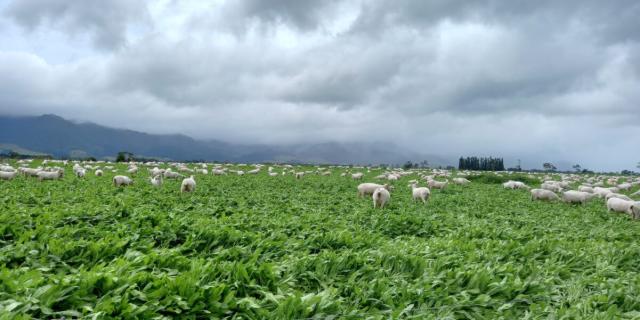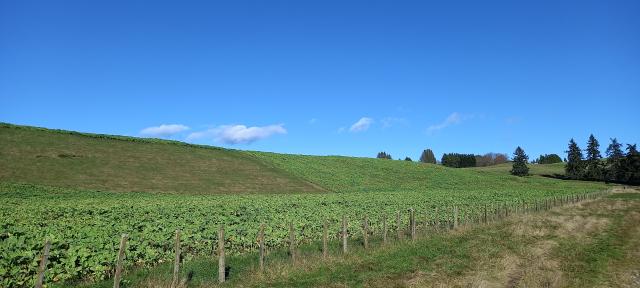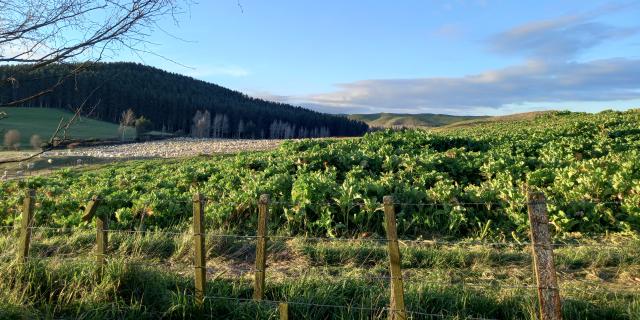Do crops have less worm larvae on them? What’s the best crop for low worm challenge? What if there’s lots of grass through my crop? Learn about worm challenge on different forage types, and approaches to managing worms and drench inputs while animals are grazing crops.

Why crops?
Crops not only provide a less favourable habitat for worm larvae, but can also provide better nutrition, to grow young stock more quickly through their most vulnerable months.
That said, the level of worm challenge on crops can vary substantially and monitoring is very important to safely reduce drench use while grazing young stock on these.
Which crop is best?
Its not always possible to say which forage will be ‘best’ – ‘Whatever green, leafy high ME crop will grow in your environment and under your management’ – is a pretty good guide. On some farms, crops may not be the best choice and a mix of other approaches may be better.
When it comes to where worms like to live, the number one rule is larvae like grass best (see Worms on pasture/Larvae like grass best).
Crop types and worms
Brassica crops and fodder beet can be a great source of low-worm challenge feed. If there is grass through the crops or around the edges, they may still harbour some worm larvae. The broad leaf structure, bulb and/or stalk all present a less favourable environment for worm larvae than grass.
These crops are typically grazed out completely and then re-sown, either into another crop, or new grass.
It is unlikely that substantial numbers of worm larvae will survive this process. So it’s possible to drench directly onto brassica/beet crops without worrying too much about creating a ‘resistant worm’ hot-spot.
If you include grass in summer brassicas or use a mix such as kale and plantain (where the plantain continues on after the brassica has been grazed out) you need to be more careful.
Multi-year crops such as lucerne, plantain, chicory, pure clover and their mixes all provide excellent nutrition to stock. When they are first established, they can also present very low worm challenge. Drench inputs can and should be reduced while grazing these.
Because these crops usually start life with low levels of worm larvae on them, it is possible for them to become ‘hot-spots’ of resistant worms if drenches are not used carefully. Indiscriminate drench use can quickly lead to a high percentage of the worm larvae on these swards being drench survivors.
Think about ways you can introduce ‘good worms’ (refugia) into these areas without over-contaminating them with worm larvae:
- Initial grazing of new crop with undrenched older animals.
- Periodic grazing of crop with undrenched older animals.
- Undrenched older animals run in the mobs of young stock that are grazing the crop (e.g. light ewes that need to gain weight).
- Young stock that are due for a drench are introduced to the crop for a few days and then drenched. This is safer than drenching straight on but depending how many previous drenches they’ve had (and how effective the drench has been) there could still be a high proportion of resistant worms in the animals.
- Leave a percentage of animals undrenched each time treatments are given while grazing the crop (Targeted Selective Treatment/TST).
- Use extended drench intervals and use monitoring to ensure that this is safe.
Lotus, Sulla and Chicory are examples of forages that contain condensed tannins. Willow also contains CTs.
Condensed tannins form complexes with plant proteins in the rumen. This makes these proteins ‘unavailable’ to the rumen microbes to break down. Excess protein in the rumen is usually ‘lost’ as urea, but when condensed tannins are present, the extra protein enters the abomasum (rumen bypass) and is then available to the animal to digest. This extra protein can ‘offset’ some of the protein being lost through parasitism.
Condensed tannins have been shown to inhibit the movement of worm larvae.
Trials with young stock on CT-containing forages have shown that high liveweight gains are possible even when the animals are carrying parasites at a level that might otherwise restrict their growth.
For a review of other plants that may or may not have worm-management potential, check out the Deer Parasite Information Booklet (page 65 onwards), on Deer Industry NZ’s Deer Hub.

Does method of crop establishment matter?
Crops and grass swards established via tillage, where the grass layer is either buried or broken up, are likely to have less worm larvae in them at the beginning. The new crop or grass should be grazable by lambs or calves with a lower level of regular drench input than on permanent pasture. But MONITOR, to assure that unexpected worm challenges do not occur.
As long as the pre-existing sward/crop has been grazed to a low level and desiccated (dried out) via spraying, crops and grasses established via no-till methods can also present substantially lower worm challenge to stock than the previous, old, pasture. MONITOR, to assure that unexpected worm challenges do not occur.

Watch those grassy edges!
Sometimes in crop paddocks there are areas of old grass, either throughout the crop or around sidings. Young stock sometimes graze the grass heavily first, while getting used to the new feed. They can then become ‘unexpectedly’ infected with worms.
Solutions to this could be:
- Grazing lambs through a crop with their mums in the week or two before weaning, so that they are used to the new forage.
- For calves: feed baleage, meal, or another feed type that calves are used to, as well as the crop, until they adapt.
- Drench the calves or lambs a few days after they have been introduced to the crop, to remove worm larvae that they’ve picked up while grazing the grass parts.
Run-off paddocks

Run-off paddocks are often used with crops. A run-off paddock is a grass paddock adjacent to the crop, where animals can go by free choice, or given an allocated time on crop and then moved back into the run-off paddock.
Run-off paddocks can become heavily contaminated with worm larvae, especially if the animals are young or have compromised worm immunity. Monitor animals carefully in case worm burdens build up. Underfeeding on crops is a common underlying issue when animals become parasitised whilst grazing crops. Give them plenty to eat!
Supplement with crops
Hay, silage and baleage will not contain significant (or any) worm larvae. You can presume these conserved forages are another source of ‘worm free’ feed.
Drenching on crops
Be mindful of refugia if drenching young stock on multi-year crops such as chicory or plantain, where a population of drench resistant worms could build up.
For short term crops that will be grazed out to open ground and re-sown in another forage or grass, this is less important. Few resistant worm larvae are likely to survive this process.
Monitoring on crops
An easy approach to knowing if young animals require a drench while grazing a crop (or area of new grass) is to perform a faecal egg count (FEC) at the expected drench interval.
For example if lambs are drenched and weaned onto a brassica crop, rather than drench at 28 days, take a FEC and use the result to decide whether:
- The lambs should get a drench now (egg counts are unexpectedly high and/or lambs are showing signs of parasitism).
- Or re-check again in another couple of weeks (egg counts are zero or low and lambs are doing well on the crop).